Mans best friend
Clement Walton, from Maine, USA, who first developed this thought about mans co-evolution parallel with the dog, inspired me to write these lines as an introduction to his article, and to travel around in Sweden to photograph some interesting rock paintings and carvings to illustrate the lot. Altogether it was a very worthwhile effort.
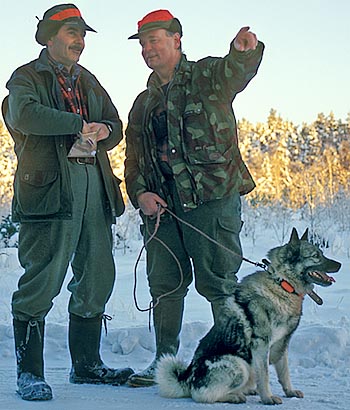 |
|
The Norwegian Grey Elkhound is believed to be a very close relative to the Scandinavian hunting dogs of the Stone Age. Remove the radio tracking collar from around the dogs neck and give these two braves spears instead of firearms, and we can turn the clock back 6000 or 12 000 years for them. All else will be equal. I have found that this breed is my personal favourite among the breeds that in English are called "hounds". It is a very friendly, good looking and easy to train breed of dogs, yet very courageous and stubborn when hunting. It is equally good for elk as well as the wild boar or the bear. This could be a heritage from the Stone Age, perhaps?
|
Introduction: Text, photo and caption by Torsti Mäkinen
 In 1989, when Maud and I started to learn about gundogs in order to be able to properly greet welcome to our first puppy, that we received a year later, I did not have even a vague suspicion that I almost 20 years later would be writing a story connected to their history as a mans best friend. Learning some about dogs enticed me into learning more. I did not only learn about how to train dogs and about their behaviour but I also got interested in their history, particularly the British breeds of pointing birddogs, and the working spaniels history. However my interest in their history did not reach very far beyond the point when they had started to develop into working gundogs in their respective speciality. In 1989, when Maud and I started to learn about gundogs in order to be able to properly greet welcome to our first puppy, that we received a year later, I did not have even a vague suspicion that I almost 20 years later would be writing a story connected to their history as a mans best friend. Learning some about dogs enticed me into learning more. I did not only learn about how to train dogs and about their behaviour but I also got interested in their history, particularly the British breeds of pointing birddogs, and the working spaniels history. However my interest in their history did not reach very far beyond the point when they had started to develop into working gundogs in their respective speciality.
 Anyway, at that time when I started to learn about dogs, there was scientific proof that man and dog had lived together at least around 15000 years. In Scandinavia a skeleton in good condition from a Stone Age dog had been found somewhere in the southern Norway. It was dated to be around 10 000-12 000 years old and it resembles in all essentials the modern Norwegian Grey Elk hound. Today the time span of man and dog together has widened a lot. There is new evidence showing that we have been together for at least 35 000 years, in a global perspective. Here in the Scandinavia such a long continuous era of life is impossible due to the last ice age. 20 000 years ago Scandinavia was still covered with kilometre thick ice. Perhaps 8000-10 000 years ago the ice had partly melted, and the ice edge had drawn back enough to permit people to migrate in from the south. Anyway, at that time when I started to learn about dogs, there was scientific proof that man and dog had lived together at least around 15000 years. In Scandinavia a skeleton in good condition from a Stone Age dog had been found somewhere in the southern Norway. It was dated to be around 10 000-12 000 years old and it resembles in all essentials the modern Norwegian Grey Elk hound. Today the time span of man and dog together has widened a lot. There is new evidence showing that we have been together for at least 35 000 years, in a global perspective. Here in the Scandinavia such a long continuous era of life is impossible due to the last ice age. 20 000 years ago Scandinavia was still covered with kilometre thick ice. Perhaps 8000-10 000 years ago the ice had partly melted, and the ice edge had drawn back enough to permit people to migrate in from the south.
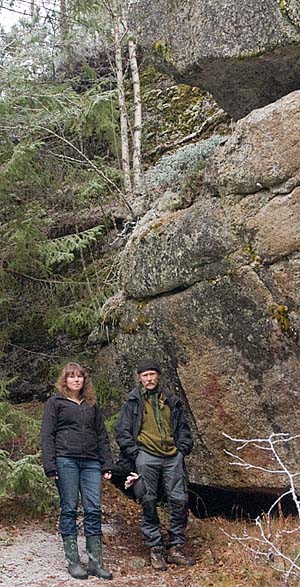 |
With the kind assistance from my guide, the archaeologist Bernt Ove Viklund, and my local camera assistant Anna Näsmark to the left, I was able to without any trouble find the oldest rock painting representing a dog in Sweden. The place was in a deep, dark forest on a steep side of a rock, in northern Sweden. To think that nearly 6000 years ago some other hunter had been here and left a message for me to interpret was amazing. Anyway: Thanks Anna and Bernt for making my day so easy!
|
 These Stone Age people were to start with nomadic hunters that later developed into more domiciled Bronze Age hunters, fishermen and stock farmers. In the northern part of Sweden there are thousands of rock paintings (the older form of rock art) and rock carvings that witness of the huge importance the elk (Alces Alces) had in their everyday life. It did not only provide food and material for clothes, tools and other things benefiting the life, but it is believed that it also played an important part in their spiritual world. These Stone Age people were to start with nomadic hunters that later developed into more domiciled Bronze Age hunters, fishermen and stock farmers. In the northern part of Sweden there are thousands of rock paintings (the older form of rock art) and rock carvings that witness of the huge importance the elk (Alces Alces) had in their everyday life. It did not only provide food and material for clothes, tools and other things benefiting the life, but it is believed that it also played an important part in their spiritual world.
 It is difficult or impossible to put oneself into the place of a Stone Age man unless we first can clear our brain and conscience entirely from modern knowledge, religion and way of thinking. The ancient folks are most often described as highly spiritual and they could just as well have been that way. The symbols they left behind in the form of remains of settlements, tools, paintings, jewellery and carvings can be interpreted in as many way's as there are interpreters, although the archaeologists most often in the end come to some mutual agreement, thereby bringing some clarity in the case for the sake of the public, and the science in general. The only today living key we may have to the thinking of the ancient man might be found in the few tribes of true Stone Age-like aboriginals that still lives in some parts of the South American and Indonesian jungles. Then again; environment model the individual and what was holy and full of spirit in one place may not have been so in some other parts of the world. It is difficult or impossible to put oneself into the place of a Stone Age man unless we first can clear our brain and conscience entirely from modern knowledge, religion and way of thinking. The ancient folks are most often described as highly spiritual and they could just as well have been that way. The symbols they left behind in the form of remains of settlements, tools, paintings, jewellery and carvings can be interpreted in as many way's as there are interpreters, although the archaeologists most often in the end come to some mutual agreement, thereby bringing some clarity in the case for the sake of the public, and the science in general. The only today living key we may have to the thinking of the ancient man might be found in the few tribes of true Stone Age-like aboriginals that still lives in some parts of the South American and Indonesian jungles. Then again; environment model the individual and what was holy and full of spirit in one place may not have been so in some other parts of the world.
 The oldest rock painting representing a dog that has been found in Sweden is dated to be 4000-6000 years old. The painting, heavily worn by time and lacking a lot of its original sharpness, has been interpreted to represent a hunting dog barking at an elk. This is precisely the way we hunt elk today with elkhounds. The dog searches for and finds the elk. Then it keeps the elk occupied with its barking, simultaneously disclosing its position to the human hunter, who can cautiously sneak up and shoot the elk at a short distance. The Stone Age man most likely was a lot more skilful stalker and had no difficulties to come even closer to kill the elk with a spear. Here is an example of the very efficient cooperation between man and dog that has lasted for thousands of years to the benefit of them both. The oldest rock painting representing a dog that has been found in Sweden is dated to be 4000-6000 years old. The painting, heavily worn by time and lacking a lot of its original sharpness, has been interpreted to represent a hunting dog barking at an elk. This is precisely the way we hunt elk today with elkhounds. The dog searches for and finds the elk. Then it keeps the elk occupied with its barking, simultaneously disclosing its position to the human hunter, who can cautiously sneak up and shoot the elk at a short distance. The Stone Age man most likely was a lot more skilful stalker and had no difficulties to come even closer to kill the elk with a spear. Here is an example of the very efficient cooperation between man and dog that has lasted for thousands of years to the benefit of them both.
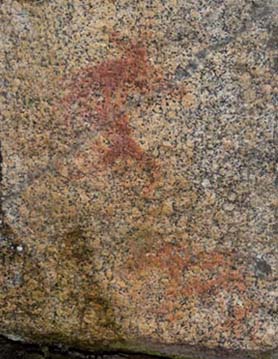 |
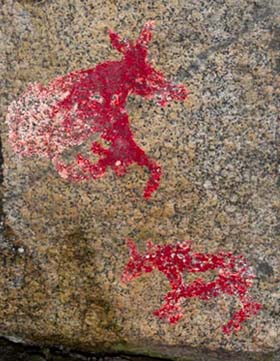 |
The rock painting had worn a lot due to the weather and wind, sun and frost, rain and draught. Still it is fascinating to see how much of it remained after such a long time under those testing conditiones.
The Stone Age people made the paint out of ochre and animal fat. Ochre is a mineral consisting of iron oxides and that could be the explanation for its ability to last during such a long time. In my cutout of the picture you see a dog barking at an elk at the top, and at the bottom there is an other elk. There were 6 or 7 other paintings on the rock but I had to limit myself to this one presenting the dog. |
Well, you did not see much from the first photo, or did you? Neither did we so we put it in the Adobe Lightroom and then the Adobe CS3 photo editor. First all the colours that had nothing to do with the old paint were removed. Then the colour of the paint itself was reinforced, sharpened and highlighted. Now suddenly hundreds of invisible small fragments of the old paint on the rock were visible again and we could also see that the paint had kind of flown down the rock and also spread to the sides of the objects, probably due to the capillary effect of the animal fat in the paint in contact with the porous rock. To make sure that the photo editor had not created all the small fragments of paint we used the clean rock area, a few inches to the right of the elks nose as a control area. It was still clean. Now we had a problem. Should we show all the fragments in this improved picture or should we try to make an approximation of the original painting? We stuck to the last solution and lifted only what we thought was the most important fragments out of the in Photoshop maltreated picture and put them back on the untreated photo. Hence the rear end of the upper elk is entirely a product of my own imagination and should not be regarded seriously. The front end was a lot easier to work with and the lower elk was not very difficult. However, now that I have studied the original picture about a thousand times, I think I can see the dog more clearly in the original painting. It seems to take some training to become an archaeologist, indeed. |
 The man and the dog have cooperated and benefited from each other in many other ways. During the ages the dog living in the human pack has done many important duties. Machines cannot even today, as efficiently do some of them. They have guarded and defended their human pack. They have pulled and carried goods. They have herded cattle and protected them from predators. They have been social and entertained adults and played with and comforted children. In modern times the dog's importance as a worker and partner to the human race has in no way declined. It seems like almost each day new duties, which cannot be done by machines, are invented for our working duty dogs. The man and the dog have cooperated and benefited from each other in many other ways. During the ages the dog living in the human pack has done many important duties. Machines cannot even today, as efficiently do some of them. They have guarded and defended their human pack. They have pulled and carried goods. They have herded cattle and protected them from predators. They have been social and entertained adults and played with and comforted children. In modern times the dog's importance as a worker and partner to the human race has in no way declined. It seems like almost each day new duties, which cannot be done by machines, are invented for our working duty dogs.
 In this perspective it does not seem unlikely that the human race has benefited so much from dogs, that an unintentional and unconscious selective evolution of humans must have taken place during ten thousands of years. The man who by nature had an ability to understand dogs and communicate with them, was also able to utilize the combined power of the dogs sagacity, courage and superior senses and his own intelligence and handiness, had without doubt a better change to be successful than the one who lacked this ability. (Since mammalian females instinctively select the successful male as a partner, the dog-wise man had an advantage and voila', we have a selection! Am I right or wrong?) In this perspective it does not seem unlikely that the human race has benefited so much from dogs, that an unintentional and unconscious selective evolution of humans must have taken place during ten thousands of years. The man who by nature had an ability to understand dogs and communicate with them, was also able to utilize the combined power of the dogs sagacity, courage and superior senses and his own intelligence and handiness, had without doubt a better change to be successful than the one who lacked this ability. (Since mammalian females instinctively select the successful male as a partner, the dog-wise man had an advantage and voila', we have a selection! Am I right or wrong?)
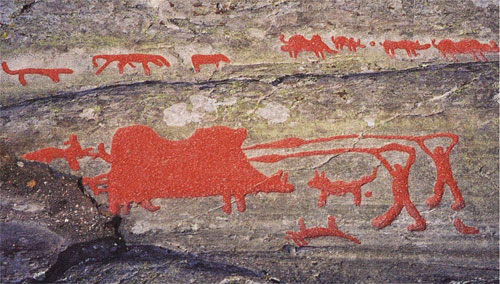 |
If the elk was important in the north, then the wild boar was just as important in the southern Sweden. There we find these younger rock carvings from the Bronze Age from the west coast to the east coast, almost everywhere, as it seems. Here we have 3 dogs working with a huge wild boar. One of them is holding it in the tail, the other one in the front is barking at it and the third one has obviously been seriously injured by the boar or is even killed, lying on its side on the ground. Two hunters are about to kill the boar with spears. Change the spears to firearms and the picture could have been from today!
|
 As mentioned earlier we cannot for sure imagine the ancient folks relation to dogs. However, it is unlikely that an efficient use of the dogs permitted a much different relation from the one we have today. Certainly dogs are very adaptable and can take a lot of abuse and still remain faithful but we have reasons to believe that they were treated well. To start with the modern religion, stating that animals have no soul and hence can be treated more or less ruthlessly, did not exist in those days. From American Indians we know that animals were regarded as brothers and sisters to man. Secondly some dogs were buried with the same respect and splendour as was given to the most influential headmen and chiefs of a tribe, so they may well have been a lot more appreciated than after the Christianity came to dominate our life. As mentioned earlier we cannot for sure imagine the ancient folks relation to dogs. However, it is unlikely that an efficient use of the dogs permitted a much different relation from the one we have today. Certainly dogs are very adaptable and can take a lot of abuse and still remain faithful but we have reasons to believe that they were treated well. To start with the modern religion, stating that animals have no soul and hence can be treated more or less ruthlessly, did not exist in those days. From American Indians we know that animals were regarded as brothers and sisters to man. Secondly some dogs were buried with the same respect and splendour as was given to the most influential headmen and chiefs of a tribe, so they may well have been a lot more appreciated than after the Christianity came to dominate our life.
 |
The Bronze Age dog was without doubt a true versatile dog. This rock carving is easy to interpret even for the amateur archaeologist. We started to keep sheep and goat about 10000 years ago and without any hesitation we can see that this dog and the man are herding some kind of cattle.
|
 Some years ago geneticists in Finland claimed that they had with DNA-analysis tracked the dog back in history to the first 4 individuals. Together with other sources they claim that our domestic dog descends from a now extinct small wolf that lived in the East Asia. Should this be true it would indicate that the ancient man regarded the dog to be important enough to follow him to every corner of the world, a journey the dog may not have been able to do by its own powers. In other words our dogs origin has no connection to the Siberian grey wolf, or the Timber wolf in the USA, that together with subspecies has always lived on the northern hemisphere around the Artic for ages. Some years ago geneticists in Finland claimed that they had with DNA-analysis tracked the dog back in history to the first 4 individuals. Together with other sources they claim that our domestic dog descends from a now extinct small wolf that lived in the East Asia. Should this be true it would indicate that the ancient man regarded the dog to be important enough to follow him to every corner of the world, a journey the dog may not have been able to do by its own powers. In other words our dogs origin has no connection to the Siberian grey wolf, or the Timber wolf in the USA, that together with subspecies has always lived on the northern hemisphere around the Artic for ages.
  
Smart dogs, smart humans?
Text by Clement Walton. Photo and caption Torsti Mäkinen
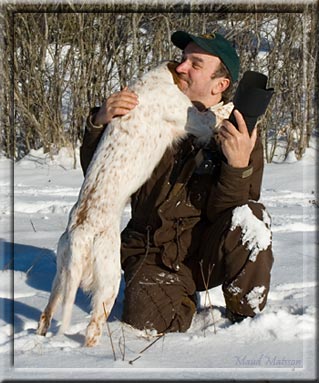 |
How come that we liked each other's company so much? There is no mistaking in that the late Foxy and me were more than just ordinary friends. It seems like dog and men are uniquely tied together and the evidence for this are the positive physiological effects taking place when we touch each other. In both dog and man the blood pressure and heart rate drops, and the stress relieving hormone oxytoxin is produced, giving us a feeling of delight. Lately one of the new tasks our dogs in Sweden have got are to be trained to therapy dogs. They visit patients at elderly homes and hospitals. Their visits cause measurable positive medical effects as well as a relaxing and comforting mental stimulation for the patients.
|
 The intellectual advantage that dogs have over wolves is their readiness to seek help from a human pack member, something that wolves cannot do.
My dogs have trained me to respond to their requests in a relatively complete fashion since they have trained me to open the door when they want to go out and to take them for a ride when they want to see the countryside. They were exceptionally efficient in training me to hunt properly and to take them hunting when they wanted to go. Wolves don't solicit help with a problem whereas dogs show no hesitation in demonstrating their needs and emotional state to a human. Since dogs can efficiently solicit help from a human they take advantage of human intelligence to a greater degree than any other species. I consider that ability to be part of a dog's intelligence. The intellectual advantage that dogs have over wolves is their readiness to seek help from a human pack member, something that wolves cannot do.
My dogs have trained me to respond to their requests in a relatively complete fashion since they have trained me to open the door when they want to go out and to take them for a ride when they want to see the countryside. They were exceptionally efficient in training me to hunt properly and to take them hunting when they wanted to go. Wolves don't solicit help with a problem whereas dogs show no hesitation in demonstrating their needs and emotional state to a human. Since dogs can efficiently solicit help from a human they take advantage of human intelligence to a greater degree than any other species. I consider that ability to be part of a dog's intelligence.
 Many of my dogs' behaviours are asking for something, the trick is learning what they need help with. I encounter many dog handlers that are only too willing to try to teach or direct a dog in how to hunt when the dogs need no help. I run into babblers all the time and, quite interestingly, they are ready to direct the dog in the field but haven't a clue when the dog actually requests their help. Many handlers cannot shut up during a field search but when the dog is retrieving blind it will often look to the handler to solicit guidance and the handler stands mute... what a peculiar dichotomy. After training
and working with a few retrievers the trainer often learns to use body language and subtle signals to guide the dog under difficult retrieving conditions.
Eventually the 'hup' or 'sit' command takes on a new meaning, it says "pay attention to me" and the dog comes to expect a human signal of some sort after receiving such a command. Dog body language can be very subtle as can human body language, you tell your dog far more than you know. Many of my dogs' behaviours are asking for something, the trick is learning what they need help with. I encounter many dog handlers that are only too willing to try to teach or direct a dog in how to hunt when the dogs need no help. I run into babblers all the time and, quite interestingly, they are ready to direct the dog in the field but haven't a clue when the dog actually requests their help. Many handlers cannot shut up during a field search but when the dog is retrieving blind it will often look to the handler to solicit guidance and the handler stands mute... what a peculiar dichotomy. After training
and working with a few retrievers the trainer often learns to use body language and subtle signals to guide the dog under difficult retrieving conditions.
Eventually the 'hup' or 'sit' command takes on a new meaning, it says "pay attention to me" and the dog comes to expect a human signal of some sort after receiving such a command. Dog body language can be very subtle as can human body language, you tell your dog far more than you know.
 The classic and most easily diagnosed dog question is seen in the water retrieve in versatile dog tests, it is the solicitation of help, the dog swims out and suddenly turns and looks to the handler, the dog is waiting for the handler to throw a stone to direct it towards the bird. The naive trainer will, more often than not, start searching for something to throw for the dog, this is a consequence of training of the handler by the dog. With more sophistication on the part of dog and handler you can answer the dog's question by the orientation of your face or the direction of your gaze. Can
dogs engage in complex behaviours?... when a dog approaches and throws a stick or a ball at your feet it is asking you to play with it, a relatively complex request involving both solicitation and anticipation linked to a specific play object. The classic and most easily diagnosed dog question is seen in the water retrieve in versatile dog tests, it is the solicitation of help, the dog swims out and suddenly turns and looks to the handler, the dog is waiting for the handler to throw a stone to direct it towards the bird. The naive trainer will, more often than not, start searching for something to throw for the dog, this is a consequence of training of the handler by the dog. With more sophistication on the part of dog and handler you can answer the dog's question by the orientation of your face or the direction of your gaze. Can
dogs engage in complex behaviours?... when a dog approaches and throws a stick or a ball at your feet it is asking you to play with it, a relatively complex request involving both solicitation and anticipation linked to a specific play object.
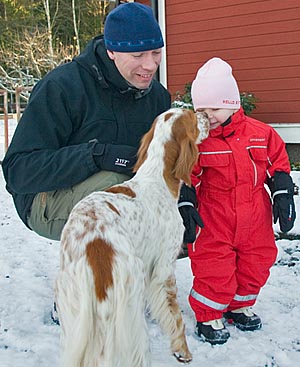 |
A dog does recognize adult humans from children as easy as they recognize a puppy from an adult dog. The investigation of a child by sniffing is done the same way as with a puppy, by sniffing the face. Adult humans and adult dogs are sniffed over on the lower body parts, as we all know. This could indicate that dogs consider us as almost equal to dogs. How come?
|
 My dogs have a half dozen or so barks or sounds that have specific meanings and an extensive repertoire of body language to engage my attention. In this I found that mallard ducks and black ducks are more vocally communicative than dogs in that they have a richer sound vocabulary of calls whereas the dogs have a more extensive body language vocabulary. Most forms of contact that I have with my dogs are instances in which the dogs want or need something from me, of course the converse is also true, when I have an interaction with one of my dogs usually I want something as well. A lot of this kind of behaviour is termed allelomimetic, a fancy word that essentially means they're copying the body language of their pack mates. Yes, dogs learn a lot of behaviours from other dogs since they are pre-programmed for learning body language. It is also important for the trainer to understand that dogs learn a lot of their body language signals from humans, a form of communication that is particularly difficult to diagnose. Dogs can, and do think about things that interest them and are far more than simple responders to external cues. You can spend your whole life-reading dogs and still encounter new language from both old and new dogs. My dogs have a half dozen or so barks or sounds that have specific meanings and an extensive repertoire of body language to engage my attention. In this I found that mallard ducks and black ducks are more vocally communicative than dogs in that they have a richer sound vocabulary of calls whereas the dogs have a more extensive body language vocabulary. Most forms of contact that I have with my dogs are instances in which the dogs want or need something from me, of course the converse is also true, when I have an interaction with one of my dogs usually I want something as well. A lot of this kind of behaviour is termed allelomimetic, a fancy word that essentially means they're copying the body language of their pack mates. Yes, dogs learn a lot of behaviours from other dogs since they are pre-programmed for learning body language. It is also important for the trainer to understand that dogs learn a lot of their body language signals from humans, a form of communication that is particularly difficult to diagnose. Dogs can, and do think about things that interest them and are far more than simple responders to external cues. You can spend your whole life-reading dogs and still encounter new language from both old and new dogs.
 We have evidence that man and dog have been together for perhaps 35 000 years and in that time there has been some co-evolution. We have dogs that almost seem to instinctively understand human emotional states and human body language but even more interesting is the behaviour of humans that seems to instinctively adapt to dog body language. It is almost automatic for humans to encourage a dog to approach by squatting down and holding out the hands. This behaviour is naturally a releaser for the approach of an uncertain dog. Why does spreading out the arms encourage a dog to come to a human? We have many unlearned responses and behaviours that trigger innate behaviours in the domestic dog that seem to be automatic body language interactions understood by the dog. We have evidence that man and dog have been together for perhaps 35 000 years and in that time there has been some co-evolution. We have dogs that almost seem to instinctively understand human emotional states and human body language but even more interesting is the behaviour of humans that seems to instinctively adapt to dog body language. It is almost automatic for humans to encourage a dog to approach by squatting down and holding out the hands. This behaviour is naturally a releaser for the approach of an uncertain dog. Why does spreading out the arms encourage a dog to come to a human? We have many unlearned responses and behaviours that trigger innate behaviours in the domestic dog that seem to be automatic body language interactions understood by the dog.
 Yawning is one of the inexplicable behaviours of humans and it is contagious, a yawn will trigger yawns from other human observers. This is an interesting phenomenon since we have known for years that our closest animal relative, the chimpanzee, can also be triggered to yawn by observing a human yawn, the behaviour is contagious across two closely related species. Recent research has shown that contagious yawning can be demonstrated in one other species, the dog will respond to human yawns by yawning itself. Now we have three species that display interspecific contagious yawning. Yawning is one of the inexplicable behaviours of humans and it is contagious, a yawn will trigger yawns from other human observers. This is an interesting phenomenon since we have known for years that our closest animal relative, the chimpanzee, can also be triggered to yawn by observing a human yawn, the behaviour is contagious across two closely related species. Recent research has shown that contagious yawning can be demonstrated in one other species, the dog will respond to human yawns by yawning itself. Now we have three species that display interspecific contagious yawning.
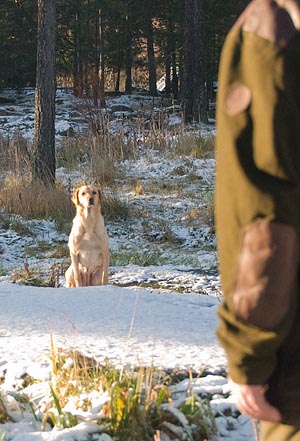 |
Dogs have an amazing ability to communicate with, and understand humans. The retriever can be directed with very high precision over long distances. It is plausible to believe that this ability is a result of a long mutual co-evolution together with the man. In other words a dog and a man together has been a lot more successful combination than either of them alone, and hence we have become genetically adapted to each other. Today we can see the result of this co-evolution in the natural ease of communication we have with our dogs.
|
 I can easily understand how a body language sensitive social animal such as the dog can learn to respond to humans but how do humans instinctively know so much about dog behaviour? Why do dogs "grin" at humans and yet never display this signal to other dogs? Why does the heart rate and blood pressure of both dog and human fall when they are in physical contact? What is the reciprocal calming effect that both man and dog experience when a man strokes
a dog's back? Dogs have been selectively adapted to man but it also seems that man is selectively adapted to dogs. I can easily understand how a body language sensitive social animal such as the dog can learn to respond to humans but how do humans instinctively know so much about dog behaviour? Why do dogs "grin" at humans and yet never display this signal to other dogs? Why does the heart rate and blood pressure of both dog and human fall when they are in physical contact? What is the reciprocal calming effect that both man and dog experience when a man strokes
a dog's back? Dogs have been selectively adapted to man but it also seems that man is selectively adapted to dogs.
 After examining my own emotional responses to dogs I find that I respond to them in ways that don't occur to me when I encounter a wolf, fox or coyote. Part of this difference is learned but part of it is innate. As far as I can tell humans can readily learn to read a dog but it is a more difficult task to learn to read a wolf or coyote. Why is it so much easier for us to interpret a dog's emotional state than it is to judge how a wolf will respond to a human? After examining my own emotional responses to dogs I find that I respond to them in ways that don't occur to me when I encounter a wolf, fox or coyote. Part of this difference is learned but part of it is innate. As far as I can tell humans can readily learn to read a dog but it is a more difficult task to learn to read a wolf or coyote. Why is it so much easier for us to interpret a dog's emotional state than it is to judge how a wolf will respond to a human?
 When it comes to interactive sniffing, that is scent investigation by a dog, dogs selectively determine what parts of another dog or person are sniffed. These body areas are different for mature dogs and puppies and they are equally different for adult humans and children. Why does a dog recognize a juvenile human and sniff different body areas than it does with an adult human? With children dogs sniff the face and head but with adults they sniff the same body areas that they do with other mature dogs, a social distinction made by no other animal species. When it comes to interactive sniffing, that is scent investigation by a dog, dogs selectively determine what parts of another dog or person are sniffed. These body areas are different for mature dogs and puppies and they are equally different for adult humans and children. Why does a dog recognize a juvenile human and sniff different body areas than it does with an adult human? With children dogs sniff the face and head but with adults they sniff the same body areas that they do with other mature dogs, a social distinction made by no other animal species.
 Humans have undoubtedly selected almost the entire behavioural repertoire of domestic dogs but it appears that in so doing we have been modified by our dogs. We are interesting paired species that may have more in common than we expect. Humans have undoubtedly selected almost the entire behavioural repertoire of domestic dogs but it appears that in so doing we have been modified by our dogs. We are interesting paired species that may have more in common than we expect.
Clement Walton
 Back to Torstis Corner! Back to Torstis Corner!
© Layout Maud Matsson
|
|

